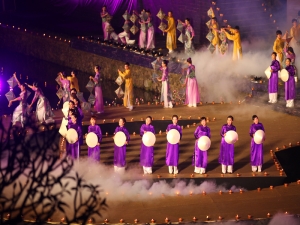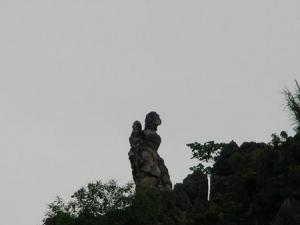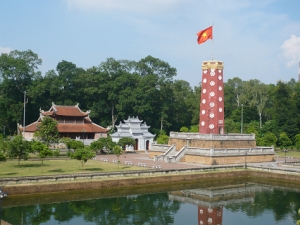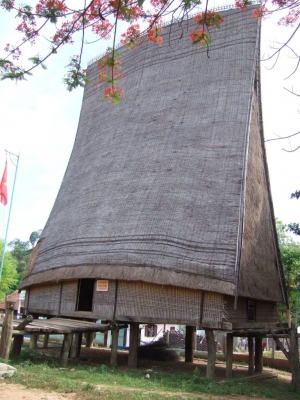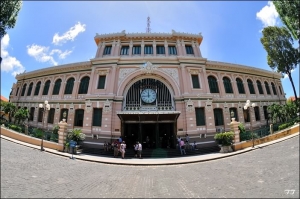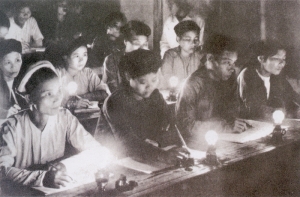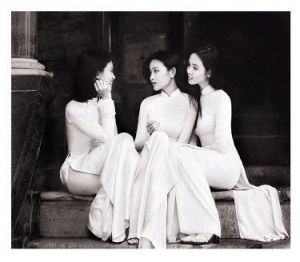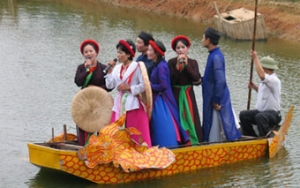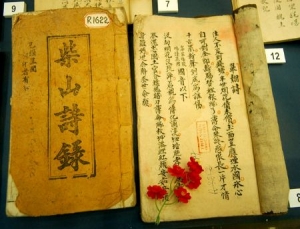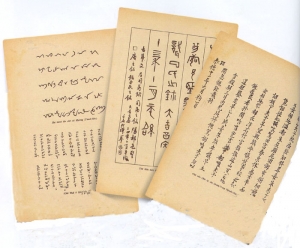
Asia Pacific Travel Team
Festival Hue 2012 - Vietnam
The connection between Thua Thien Hue province and its local areas to organize a national tourism year expresses in enhancing advertisements on electronic news, exhibitions, fairs....and festivals, including Festival Hue 2012.
Legend of "Vong Phu" mountain
It's the legend about the mountain of a woman who is waiting for her husband.
Once upon a time there lived in the highland of northern Vietnam a boy orphaned of both his mother and father. He lived with his little sister in a small cottage on the slopes of a hill.
Every day at early dawn he went to the forest not far from his house to chop wood. He took the wood to the market to sell for food and provisions. The rest of the day he devoted to his little sister, whom he cherished and cared for lovingly.The brother and sister were very happy in their small cottage, until, one day, a stranger arrived. The newcomer was an old man, who, passing by the place one evening, asked for lodging.
When the brother learned that the stranger was a prophet, he eagerly requested his guest to foretell the future. The old man referred to his book and told the boy: "The date and hour of your birth most certainly indicate that you will some day marry your own sister.
"The old man continued: "It is irrevocable. No-one can act against his fate." The boy regarded the old man's words as nonsense and did not care about them any more.
One nice day, the young man brought his sister with him to the forests. There, the little girl was watching and listening to the birds, while her brother chopped wood.
Suddenly, the hatchet's edge dropped upon the girl's head. The little girl fell down. Her head was bloody. The young man thought his sister died. He was very afraid of his crime, therefore, he ran away from the forest.
He did not want to return to his home and wandered far into the highland. He changed his name and settled in a place that is far from his home. He was most unhappy and grieved over the terrible thing he had done to the sister he had always loved.
However, he gradually lost himself in hard work and, at last, began to build a new life for himself.
Fifteen years later, he grew up and became the proud husband of the daughter of a very rich tradesman. A lovely child was born to complete the happiness of the devoted couple.
One day, on coming into the back yard, he found his wife drying her hair in the sun. She had removed her upper garments and when she threw her hair forward to comb it, he saw, for the first time, a deep ugly scar on her back. He approached his wife and asked her what had caused it.
The woman said in a tearful voice: "I am not the real daughter of the man you know as my father. Originally, I came from a place far away, where 1 lived in a small cottage with my elder brother. He was very kind to me and I loved him dearly."
"However, one day, 15 years ago, I went into the forests with my brother to chop wood. He made me injured by his hatchet. Thinking I was dead, he ran from the
forest."
"I was saved by a tradesman who had just lost his daughter. He took pity on me and adopted me. I have never seen my brother again and I shall never know whyhe left me alone. We had loved each other very much."
The woman's eyes were filled with tears. The man struggled to control his emotions and enquired for the name of her own father and that of her native village.
There was not the shadow of a doubt. The girl he had married was his own sister.
The shame and painful feeling swept over him. He assumed he made a terrible evil. The following morning, he found a pretext to leave his home, promising to return within six months.
Time went by, six months passed and still, the husband bad not returned home. Every night, at twilight, the anxious wife carried her child to the high peak of the mountain, overlooking the road, and watched in vain for so many days, months and years, that one day she turned to stone. There, on the lonely mountain peak, mother and child keep their eternal vigil.
This mountain, known as "Núi Vọng Phu" (or The Mountain of the Woman who is waiting for her husband ) is located not far from Lạng Sơn, quite close to the Sino-Vietnamese border. At the top of the mountain is a rock bearing the shape of a standing woman holding her child in her arms. This resemblance is striking when the sun sets on the horizon. The tale of this mountain is so touching it becomes thus one of the legends preferred by Vietnamese and gives so much inspiration to Vietnamese poets.
Son Tay ancient citadel, a military rampart with special architecture
Son Tay ancient citadel was built by King Minh Mang in 1822 to defend the western gateway to the city of Thang Long, which is now, of course, Hanoi.
Son Tay ancient citadel is located between Son Tay town, distance center of Hanoi than 40km. This is an ancient military architecture, was built in the reign of King Minh Mang in 1822. It has the style of a Vauban fortification and in time French architects praised it as a masterpiece of Vietnamese architecture.
There were four main gates also made of bee-stone (laterite), the special material from Xu Doai. The citadel was where the kings of the Nguyen Dynasty lived and worked when in the area.Citadel have quadrilateral, trapezoidal cross-sections, sincere 6m wide, 4 meters wide aspects into, there are many holes in the top to the soldiers hiding out in shooting or stabbing spears are long enemy when they climb the walls.

The four main ports: The south gate called Tien gate; the north is the Hau port, the East main and West main.
Vong Lau:
Each port on the top is guard floor (Vietnamese call Vong Lau) and only one entrance, the outside is covered Duong Ma Thanh (also known as fish bearing) the cone shape of the outer barrier.
Around the outer moat and deep 3m, wide 20m, long 1.795m, is connected to the Tich river in the southwest corner.
The outer ring is far from La Thanh (the citadel outside) is covered by land high 3.5m, pentagon, external spines dense bamboo cover. The four external ports also open look to the four directions: East, West, South, North, now called La Thanh street.
Vong Cung:
In the citadel, the important works are built on the symmetry center axis North-South. The middle is the "Vong Cung Nu" to the south, where take a rest of the King when going to inspect provinces governed by viceroys each week. Spring and Autumn period, to sacrifice whenever reference only King confer.
Before Kinh Thien palace is a large tiled courtyard, outside the radiation portal is built of brick, bank relief "Long Van Khanh Hoi" with lime mortar. Next is the "Doan Mon" has three doors, straight into the Ky Dai (flagpole) built on a square base pyramidal laterite about high 18m.
To the west is Vo Mieu, places of worship and the generals had died while bravely fighting to protect citadel. At the four corners of citadel, the past four wells to the square, built of stone steps down to the bottom of bees, about deep 6 meters, year-round food supply for troops in the townships and people in the citadel.
The middle of citadel is the ancient flag tower is painted bright red and new stones are now where moss-covered ones used to be.
After nearly 200 years, been many wars and devastating time, ancient Son Tay citadel largely destroyed, leaving only the walls, doors, money, door post, two cannons, the foundation of Kinh Thien palace, the wells ...
You can find two ancient gates under hundred-year-old trees.

Son Tay ancient citadel is coved by green trees.There is the moat that surrounds ancient citadel. It's really quiet and cool for walking.
Son Tay citadel should be one of the great symbols of Vietnam’s cultural heritage together along with Co Loa ancient citadel, Hanoi citadel and Hue Imperial palace.
Rong House, the pride of Highlanders
That is kind of communal house, can only be found in villages to the north of the Central Highlands, especially in Gia Lai and Kon Tum provinces. It is a large, imposing, beautifully decorated stilt house built in the middle of the village. It is where community activities take place, reception of guests, meetings, wedding ceremonies, or praying ceremonies. It is also the place for reception of guests. Each ethnic minority group has specific architectural style for designing and decorating the Rong House. However, most Rong Houses share common features.
In the village, it is often the biggest house roofed with yellow-dried gianh leaves and having 8 big wood columns. The roof of a rong is incredibly steep and tall, like the blade of a hole. In front of a rong stands a balcony. These stilt houses serve as communal halls.
The rafters are decorated with patterns of bright colours, depicting religious scenes, legendary stories about ancient heroes, stylized animals, and other familiar things of the village life. The most salient feature of the décor of the Rong House is the image of the brilliant God of Sun.
The Rong House is a symbol of the culture of Central Highlanders, an age-old and stable culture. The bigger the house, the wealthier the village is. It is a pride of local people, also a great tourists attraction for its imposing beauty as well as its traditional value.
Admire the famous architecture of Saigon Central Post Office
Together with the Notre Dame Cathedral, Saigon Central Post Office is iconic buildings, tourist attractions as much for its architecture as its history. Saigon Central Post Office is the post office building at the centre of Ho Chi Minh City, District 1. It's no doubt the biggest post office in Vietnam and is an important commercial center of Ho Chi Minh City.
Vietnamese Language - a Long History
Some 3,000 years ago, communities of Mon-Khmer and Tay people merged in the northern Red River and Ma River Deltas. These two groups developed a shared language, known as Viet-Muong, which was composed of two main dialects. Lowlanders spoke what was known as the "City" dialect, while people in midland and mountain regions spoke the "Highlanders" dialect.
The Vietnamese Girl in Popular Poems
The Vietnamese girl never complaints about the condition and the role a Confucian society has assigned to her since the dawn of time. From her young age, being used to hearing popular poems incessantly sung by her mother or sister and continuing to grow up with the rhythm and the sound of the swinging hammock, she began to absorb unconsciously the recommendations found in these poems.
In spite of their simplicity, these poems began to give her not only an education worthy of Vietnamese tradition but also an incomparable resignation and the four virtues that any Vietnamese girl is deemed of possessing at her adolescence: Công, Dung, Ngôn, Hạnh (Homemaking Skills, Appearance, Speech Manners, Good Behavior). This will help her to be able to become in turn, sister, wife, mother, grand-mother during her existence. Therefore, it is not surprising to see that she has thus become one of the themes most talked about in Vietnamese popular poems.
Despite her young age, her mother's labor and wisdom have been repeated to her time and again through nursery rhymes the most known of which remains the following:
Cái ngủ mầy ngủ cho lâu,
Mẹ mầy đi cấy đồng sâu chưa về.
Bắt được con cá rô trê
Tròng cổ lôi về cho cái ngủ ăn.
Little sleeper, you have to sleep as long as possible,
Your mother has not come back from the deep rice paddy replanting seedlings.
She caught a carp and a cat fish
That she will take home for you to eat.
Then at 7-8 years of age, she began to replace her mother and imitate her in singing again the same popular nursery rhymes to lull her younger brother or sister to sleep. She also provided much service to her family: knowing how to cook rice, keeping her younger siblings, feeding the pigs and the ducks, taking water to the family animals, weeding the garden, collecting eggs, participating in family chores.
She also saw the change in the nature of her work when she reached adolescence. The nursery rhymes were replaced by folk songs or popular poems she used to hear singing often in the rice field. It is here that she would know the boys of her age. It is here that we would hear the first revelations of love, the first teasing of the Vietnamese girl through poems or folk songs. Among them, this one reveals and hides the blossoming heart of the Vietnamese girl who is shy, tender, and constrained by traditionally Confucian conditions.
Vào vườn hái quả cau xanh,
Bổ ra làm sáu mời anh xơi trầu
Trầu nầy têm những vôi tàu
Giữa đêm cắt cánh đôi đầu quế cay
Mời anh xơi miếng trầu nầy,
Dù mặn dù nhạt dù cay dù nồng
Dù chẳng nên vợ nên chồng,
Xơi dăm ba miếng cho lòng nhớ thương,
I enter the garden to pick a green betel-nut,
I cut it in six and invite you to taste this betel.
This one is spread with lime from China,
And flavored with the spice of the spice of cinnamon ends.
Please have this betel prepared by me,
Even if it is strong or light, hot or mild,
Or even if we do not become man and wife,
Just taste its flavor for you to remember.
That teasing is quick to find sympathy from the boys. To praise her beauty, these boys would not hesitate to offer not only one but ten loves at the same time, which ended up in the composition of this famous poem entitled "Mười Thương" (Ten Loves) that any young men in the old days would be deemed to know by heart:
Một thương tóc bỏ đuôi gà,
Hai thương ăn nói mặn mà có duyên,
Ba thương má lúm đồng tiền,
Bốn thương răng nhánh hạt huyền kém thua,
Năm thương dải yếm đeo bùa,
Sáu thương nón thượng quai tua dịu dàng,
Bảy thương ăn nói khôn ngoan,
Tám thương má phấn ngó càng thêm xinh,
Chín thương em ở một mình,
Muời thương con mắt đưa tình với ai!
First I love your plaited hair,
Second I love your suave and charming voice.
My next love is your dimpled cheeks,
Then your lacquered teeth more lustrous than jet is my fourth love.
Fifth, I love your bra and your necklace.
And your grand hat with velvet ribbon invites my sixth love.
My seventh love is your manner in speech,
Comes my eighth love of the makeup on your attractive cheeks.
Ninth, I love you because you are still single.
And finally tenth, because you reciprocate my loving glance.
The seductiveness of the girl only lasted for a short time because generally for the sake of socio-economic interests, she would be married very early. Many times in the past, there were financially pre-arranged marriages, which provoked criticisms and jokes through the following popular poem:
Mẹ em tham thúng xôi rền,
Tham con lợn béo, tham tiền Cảnh Hưng,
Em đã bảo mẹ rặng: đừng !
Mẹ hấm, mẹ hứ, mẹ bưng ngay vào,
Bây giờ chồng thấp vợ cao,
Như đôi đũa lệch so sao cho vừa.
Even when I had said: No
But my mother, fond of the sweet rice bucket,
Fond of the fat pig and fond of money.
With uhms and ahhs, she brought this guy in.
Now husband little, and wife tall,
We look like an unmatched pair of chopsticks after all.
Despite this remark, she accepted to become a member of the new family and be willingly submissive to all the Confucian constraints commonly seen in the Vietnamese society. She tried to meet the norms expected of her in the new family by following steadfastly the recommendations found in popular songs that she used to hear time and time again when she was still in cradle. In one of these songs, the following is found:
Con ơi! Mẹ bảo con nầy:
Học buôn học bán cho tày ngưòi ta,
Con đừng học thói chua ngoa,
Họ hàng ghét bỏ người ta chê cười.
My daughter! Listen to me,
Learn to wheel and deal as well as other people.
But try to avoid being sharp-tongued,
As this invites hate and sneer from friends and relatives.
Those are the last recommendations of her mother transmitted from one generation to the next through folk songs. The Vietnamese girl tends to keep them and apply them without failure until the end of her life. The Vietnamese woman accepts this resignation, this sacrifice, this injustice without reserve, which makes her an exemplary model worthy of admiration of her relatives, in particular her children. This is also one of the reasons that explains the profound and unshakable attachment of all Vietnamese to their mothers. The situation is illustrated by the following two verses found in one of the popular poems:
Em bán đi trả nợ chồng con,
Còn ăn hết nhịn cho hả lòng chồng con!
I do business to pay the debts incurred by my husband and my children.
It doesn't matter if I have nothing to eat, as long as they are satisfied.
Or in another, the following four verses depict not only humor but also tenderness, outstanding patience, even intangible proof of the sacrifice and love the Vietnamese woman always carries for her husband and her children:
Chồng giận thì vợ làm lành,
Miệng cười hớn hở rằng anh giận gì.
Thưa anh, anh giận em chi,
Muốn lấy vợ lẽ em thì lấy cho.
My husband is upset; I would try to calm myself.
Smile on my lips, I would ask what the reason is.
Come on, don't be frustrated any more.
Should you want a concubine, I'll get one for you.
Vietnamese Folk Songs
Nobody knows for sure the origin of Vietnamese proverbs and folk songs in terms of their inception and authors. Vietnamese proverbs and folk songs, however, are orally transmitted and incessantly edited throughout generations.
By this virtue, the proverbs and folk songs become so natural and clear that they are able to describe our customs and traditions simply and truthfully. For that reason, these proverbs and folk songs are also dubbed as Vietnamese popular literature, which proliferates by thousands of phrasings on all topics of various aspects of human life in society.
PROVERBS:
Like in other countries, Vietnamese proverbs state basic principles of folk wisdom and conduct, which have become an essential and enduring part of daily speech. They are short, succinct sayings with an intended meaning, which is to instruct or advise about something worthy of our attention. Most of Vietnamese parents use proverbs to educate their children about basic moral tenets of conduct and behavior. These proverbs are usually formed with or without rhym (E.G. An cay nao, rao cay ay : one shall cultivate the tree from which one eats fruits . An qua nho ke trong cay : when eating the fruit, one should remember those who planted the tree). The common topics of proverbs are as follows, addressing routine issues of our society’s customs and traditions such as interpersonal psychology, common experiences, moral precepts, and conduct and etiquette of politeness:
Customs and traditions: “One bite of honor earned in public is better than a banquet given in one’s own kitchen”
Real life psychology: “With love, everything becomes beautiful, with hatred, everything turns ugly”
Common experiences: “When lightning flashes relentlessly in the east, it is absolutely going to rain in the early morning (when rooster crows)”
Human maturity moral: “Good reputation is preferable to beautiful clothes”
Conduct and etiquette of politeness: “When sending a personal message, speak out; when asking people to deliver a wrapped gift to someone, leave it unsealed”.
FOLK SONGS:
These are short ballads, written in rhythm or iambic pentameter in stanzas. Folk songs are spread among common people from one generation to the next, and nobody knows their authentic authors. It is certain that folk songs are formed by multitude of composers who get inspired and let their strong feelings flow out in the form of poetry; then other people try to memorize the poems and pass them on to the public. Therefore, there is a countless number of folk songs, probably hundreds of thousand ones. There are so many generations of Vietnamese children whose mothers sing them to sleep with these types of folk songs and help them grow maturely by the profound influence of the folk songs. Also, there are so many generations of Vietnamese young adults who get married by borrowing folk songs in flirtation. Folk songs indeed manifest every fiber of the human touch deep in one’s heart and various situations of society as well. The following are some examples:
Mother’s admonition:
The fatherly immense toil is as big as ThaiSon mountain
The constant motherly devotion is similar to the stream of water flowing out from spring,
You ought to honor your parents with all your heart
In order to decently fulfill the solemn precept of filial piety
Geographical advices:
Going on road, be cautious of Ai Van mountain pass
Going by boat, be cautious of the path of billow at Hang Doi Bay
National history:
Missing you, I wanted to come to see you,
But I was afraid of The Ho’s groves, and the Tam Giang cross river
The Tam Giang cross river is dried up nowadays
And the grove is on watchful guard.
Romantic love:
You are leaving, I won’t let you go
I hold your dress flap to write a verse on it
The verse clearly exhibits the three words
Loyalty, piety, and love
The word loyalty to honor the father
The word piety to adore the mother, the word love for both of us.
Why do you, young lady, cut grass alone,
Let me join you as a couple,
Do you still continue cutting more grass?
Let me help you cutting it to become a married couple.
Due to the limit of this short writing, we can not afford to cite more examples. We are certain, however, that the proverbs and folk songs are indeed the common literature treasures of Vietnamese people: It is a common way of composing them and transmitting them from one generation to the next, and common as well in sharing the didactic values of these common treasures. The proverbs and folk songs play a significant role in providing the very first teachings on the ethical way of human conduct or individual behavior, and even knowledge on how to deal with the life situation, large and small. Particularly folk songs bring pleasure as well as entertainment to daily life with their dignified verses of courtship and romantic love. Proverbs and folk songs are truly a priceless thesaurus of Vietnamese people. It is certain to say that none of the Vietnamese can remember all of the proverbs and folk songs, but it’s also true that none can say they do not remember some.
Nom Character
From an early period a special ideographic script known as chữ nôm was also devised for transcribing spoken Vietnamese.
According to annals dating from the late 13th century, the poets Nguyễn Thuyên and Nguyễn Sĩ Cố were the first to write in chữ nôm. At the turn of the century King Hồ Quý Ly (1400-1407) himself translated the Confucian classic Kinh Thi into nôm. Thereafter an increasingly large number of other works were composed in the new script.
The era of the Lê kings (14th and early 15th centuries) was a significant period of development for chữ nôm literature. Of particular note were the works of Nguyễn Trãi, scholar and strategist to Lê Lợi (later King Lê Thái Tổ, 1428-1433) during the resistance war against the invading Ming Chinese. Trãi, whose Bình Ngô Đại cáo ('Proclamation of Victory over the Ngô') remains one of the finest works of Vietnamese national literature, left an important collection of 254 poems written in chữ nôm known as Quốc Âm Thi Tập. Though chữ Hán was the official the language of the Vietnamese royal court, two Lê monarchs - Lê Thái Tông (1434-1442) and Lê Thánh Tông (1460-1497) - are remembered for their poems written in nôm; some 300 works of great historical and literary significance written by Lê Thánh Tông may be found in the anthology Hồng Đức Quốc Âm Thi Tập ('Collected Poems of the Hồng Đức Period'). However, nôm poetry did not really begin to break free from Chinese influence until the 16th century, a process signalled by the appearance of 100 remarkable works in nôm by Confucian scholar Nguyễn Bỉnh Khiêm (1491-1585), brought together as the Bạch Vân Thi Tập ('Compilation of Bạch Vân's Poems').
The slow demise of the Lê dynasty and the corresponding rise of the powerful Trịnh and Nguyễn families during the 16th and 17th centuries seriously undermined respect for the concept of absolute monarchy, leading to the collapse of the Confucian system. This in turn had important consequences for the development of Vietnamese chữ nôm literature, which now entered a new and exciting phase of development - fresh themes appeared, and the language itself became richer, more concise and more flexible. A particular feature of the period was the appearance of stories and fables which contained thinly-veiled criticisms of official corruption and the shortcomings of feudal society.
However, the golden age for chữ nôm was the 18th century, which witnessed a truly remarkable literary flowering. Particularly popular at this time were long narrative poems known as truyện, which borrowed elements of popular oral tradition, fusing them with classical language to create new and vibrant works of literature. These works, with their complex plot, characterisation and structure, were the first to express in writing the personal feelings and desires of the protagonists. Amongst the greatest narrative poems of this period are Chinh phụ ngâm ('Lament of a Warrior's Wife') by Đặng Trần Côn, translated into nôm from the original chữ Hán by Đoàn Thị Điểm (1705-1748), and Cung oán ngâm khúc ('Lament of a Royal Concubine'), written in nôm by Nguyễn Gia Thiều (1741-1798). During the brief reign of King Quang Trung (Nguyễn Huệ, 1788-1792) chữ nôm was adopted as the national script for official texts and in education, to replace the classical Chinese which had been used for centuries.
The 18th century is known too for its satirical poems and stories, many of which vehemently attacked the ruling Confucian elite. Perhaps best known are the feminist poems of Hồ Xuân Hương (late 18th-early 19th century) and the anonymous popular stories Trạng Lợn ('Doctor Pig') and Trạng Quỳnh ('Doctor Quỳnh').
Also of significance during this period were historical works written by scholars such as L ê Quý Đôn (1726-1783), whose Đại Việt Sử Toàn Thư ('Complete History of Đại Việt') and Lê Triều Thông Sư ('History of the Lê Dynasty') marked a major advance in the development of historical studies.
Notwithstanding the revival of a strong monarchy after 1802 under the Nguyễn dynasty, Vietnamese literature continued for some time thereafter to convey the humanistic aspirations and sentiments which had featured so strongly in the literature of the previous century. The best-known work of the early 19th century and today perhaps the most famous work in the history of Vietnamese literature is the narrative poem Truyện Kiều ('The Story of Kiều'), written by poet, scholar, mandarin and diplomat Nguyễn Du (1765-1820). Highly regarded for its elegant language and style, this masterpiece relates the story of a beautiful and talented young woman condemned by the actions of a wicked mandarin to 15 years of tribulation and suffering.
During the second half of the 19th century some notable works of nôm literature were created by leading figures in the various patriotic movements set up to fight against French colonialism. These included proclamations, appeals to struggle, funeral orations, stories of combat and patriotic poems by the likes of Phan Đình Phùng, Nguyễn Quang Bích, Phan Văn Trị, Nguyễn Thông and Nguyễn Xuân Dư, together with lengthy but eloquent appeals to the monarch by Nguyễn Trường Tộ and Nguyễn Bộ Trạch. Perhaps the best-known writer of this period was blind poet Nguyễn Đình Chiểu, who composed several volumes of patriotic literature before his death in 1888.
1945-1975: Modern Literary Development of South Vietnam
Few writers of South Vietnam had gained comparatively successful achievements of literary works prior to 1945, but against a background of relative stability, prosperity and artistic freedom in the late 1950s and early 1960s. At that time, active literary scene began to emerge in South Vietnam, initially under the influence of a circle of writers, linguists and educators who had relocated from the north. Importantly, the proliferation of private publishing companies , particularly in Sai Gon, was developed remarkably.
Emigré prose writers from the north regrouping in the south after 1954 included not only established figures such as Nhất Linh, Tam Lang (Vũ Đình Chí, 1901-1986), Trọng Lang (Trần Tán Cửu, 1906-1986), Lãng Nhân (Phùng Tất Đắc, b 1907), Đái Đức Tuấn (Tchya, 1908-1969), Y Uyên (Nguyễn Văn Uy, 1911-1969) and Vũ Bằng (1913-1984) but also younger novelists and short story writers such as Nguyễn Thị Vinh (b 1924), Dương Nghiễm Mậu (Phí Ích Nghiễm, b 1936), Duyên Anh (Vũ Mộng Long, b 1936), Nhật Tiến (Bùi Nhật Tiến, b 1936), Thảo Trường (Trần Duy Hinh, b 1939), Lê Tất Điều (b 1942) and Trùng Dương (Nguyễn Thị Thái, b 1944).
It was largely under their influence that southern prose writing came of age during the period 1954-1975 with the works of Bình Nguyên Lộc (Tô Văn Tuấn, b 1914), Võ Phiến (b 1925), Sơn Nam (Phạm Minh Tày, b 1926), Ngọc Linh (Dương Đại Tâm, b 1935) and Nguyễn Thị Thụy Vũ (Nguyễn Băng Lĩnh, b 1939) from the south and Linh Bảo (Võ Thị Diệu Viên, b 1926), Minh Đức Hoài Trinh (Võ Thị Hoài Trinh, b 1930), Nguyễn Xuân Hoàng (b 1937), Túy Hồng (Nguyễn Thị Túy Hồng, b 1938), Nhã Ca (Trần Thị Thu Vân, b 1939), Nguyễn Thị Hoàng (b 1939) and Nguyễn Mộng Giác (b 1940) from the central provinces.
However, the southern literary flowering proved short-lived; whilst the overthrow of the Diệm government in 1963 brought greater artistic freedom, growing political instability, the escalation of war with the north and the steady slide into official corruption and decadence which attended the influx of large numbers of American troops in the period after 1963 engendered what one scholar has called a 'culture of entertainment'. In a radical departure from the past, a people brought up to associate literature with education and moral improvement turned increasingly for escapism to cheap imported martial arts novels and sentimental romances. In order to survive in this new climate many members of the literary community began writing daily feuilletons (serialised stories) for the newspapers, whilst others turned out novels featuring unusually racy subject matter. Nonetheless the last years of the Sài Gòn regime did see some literary works of note, notably the novels of Nhật Tiến, Lê Tất Diều and Nhã Ca with their vivid descriptions of the horrors of war.
 In the north the immediate aftermath of the August Revolution saw the establishment of the Nhân văn Giai phẩm writers movement, the name of which was drawn from its two journals Nhân văn (Humanism) and Giai phẩm (Works of Beauty). Established by a group of northern intellectuals which included writers Trần Dần, Hoàng Cầm (b 1922), Phan Khôi (1887-1959), Nguyễn Hữu Đang, Trương Tửu, Trần Đức Thảo and Thụy An, this movement aimed to secure a greater measure of intellectual independence for the Vietnamese literary community. However the trial which followed firmly established the principle that Vietnamese literature existed to advance socialism and must be guided by the Communist Party vanguard. With the establishment of the Vietnam Writers' Association in 1957 northern literature became firmly subordinated to the task of building the socialist future.
In the north the immediate aftermath of the August Revolution saw the establishment of the Nhân văn Giai phẩm writers movement, the name of which was drawn from its two journals Nhân văn (Humanism) and Giai phẩm (Works of Beauty). Established by a group of northern intellectuals which included writers Trần Dần, Hoàng Cầm (b 1922), Phan Khôi (1887-1959), Nguyễn Hữu Đang, Trương Tửu, Trần Đức Thảo and Thụy An, this movement aimed to secure a greater measure of intellectual independence for the Vietnamese literary community. However the trial which followed firmly established the principle that Vietnamese literature existed to advance socialism and must be guided by the Communist Party vanguard. With the establishment of the Vietnam Writers' Association in 1957 northern literature became firmly subordinated to the task of building the socialist future.
 During the 1960s and early 1970s the northern literary œvre continued to identify closely with the national and ideological cause. Amongst the best-known patriotic poems of this period were Chặng đường hành quân ('On the Campaign Trail', 1960) by Xuân Miễn, Cuộc chia ly màu đỏ ('The Red Farewell', 1964) by Nguyễn Mỹ (1935-1971), Ra trận ('To the Front', 1972) by Tố Hữu and Những bài thơ đánh giặc ('Poems Against the Enemy', 1972) by Chế Lan Viên. Important revolutionary poems were also written during this period by Minh Huệ (Nguyễn Đức Thái, 1927-2003), winner of numerous awards for his works on the Xô Viết Nghệ Tĩnh uprising of 1930-1931 and the life of Hồ Chí Minh; Giang Nam (Nguyễn Sung, b 1929) and Thu Bồn (Hà Đức Trọng, 1935-2003), both recipients of the Southern Revolutionary National Fatherland Front's Nguyễn Đình Chiểu Award for Literature; and a group of younger poets which included Hoàng Minh Châu (b 1930), Phạm Ngọc Cảnh (Vũ Ngàn Chi, b 1934), Nguyễn Xuân Thâm (b 1936), Võ Văn Trực (b 1936), Văn nghệ (Literary Arts) Newspaper Awards winners Dương Hương Ly (Bùi Minh Quốc, b 1940), Phạm Tiến Duật (b 1941), Bằng Việt (b 1941), Hữu Thỉnh (b 1942), Nguyễn Khoa Điềm (b 1943), Anh Ngọc (Ly Sơn, b 1943), Nguyễn Duy (b 1948), Nguyễn Đức Mậu (Hương Hài Hưng, b 1948) and Hoàng Nhuận Cầm (b 1952), playwright Lưu Quang Vũ (1948-1988) and war martyrs Nguyễn Trọng Định (1939-1968), Trần Quang Long (1941-1968) and Lê Anh Xuân (1940-1968).
During the 1960s and early 1970s the northern literary œvre continued to identify closely with the national and ideological cause. Amongst the best-known patriotic poems of this period were Chặng đường hành quân ('On the Campaign Trail', 1960) by Xuân Miễn, Cuộc chia ly màu đỏ ('The Red Farewell', 1964) by Nguyễn Mỹ (1935-1971), Ra trận ('To the Front', 1972) by Tố Hữu and Những bài thơ đánh giặc ('Poems Against the Enemy', 1972) by Chế Lan Viên. Important revolutionary poems were also written during this period by Minh Huệ (Nguyễn Đức Thái, 1927-2003), winner of numerous awards for his works on the Xô Viết Nghệ Tĩnh uprising of 1930-1931 and the life of Hồ Chí Minh; Giang Nam (Nguyễn Sung, b 1929) and Thu Bồn (Hà Đức Trọng, 1935-2003), both recipients of the Southern Revolutionary National Fatherland Front's Nguyễn Đình Chiểu Award for Literature; and a group of younger poets which included Hoàng Minh Châu (b 1930), Phạm Ngọc Cảnh (Vũ Ngàn Chi, b 1934), Nguyễn Xuân Thâm (b 1936), Võ Văn Trực (b 1936), Văn nghệ (Literary Arts) Newspaper Awards winners Dương Hương Ly (Bùi Minh Quốc, b 1940), Phạm Tiến Duật (b 1941), Bằng Việt (b 1941), Hữu Thỉnh (b 1942), Nguyễn Khoa Điềm (b 1943), Anh Ngọc (Ly Sơn, b 1943), Nguyễn Duy (b 1948), Nguyễn Đức Mậu (Hương Hài Hưng, b 1948) and Hoàng Nhuận Cầm (b 1952), playwright Lưu Quang Vũ (1948-1988) and war martyrs Nguyễn Trọng Định (1939-1968), Trần Quang Long (1941-1968) and Lê Anh Xuân (1940-1968).Throughout the American War leading prose writers of the 1940s and 1950s such as Nguyễn Công Hoan, Nguyên Hồng, Bùi Hiển, Tô Hoài, Nguyễn Văn Bổng, Chu Văn, Thanh Châu and Nguyễn Đình Thi continued to devote their work to the revolutionary cause. Other important novelists and short story writers emerging during this period included Thép Mới (Ánh Hồng, 1925-1991), Võ Huy Tâm (1926-1996), Nguyễn Trọng Oánh (1929-1993), Ngô Ngọc Bội (b 1929), Nguyễn Minh Châu (1930-1989), Nguyễn Khải (b 1930), Vũ Thị Thường (b 1930), Phan Tứ (Lê Khâm, 1930-1995), Vũ Bão (b 1931), Ma Văn Kháng (b 1936), Đỗ Chu (b 1944) and war martyrs Lê Vĩnh Hòa (1932-1967), Nguyễn Thi (Nguyễn Ngọc Tấn, 1928-1968) and Chu Cẩm Phong (1941-1971). Of particular importance was a small group of southern writers who had regrouped in the north after 1954 and now returned south into enemy territory to gather material for their compositions; these included novelists Nguyễn Quang Sáng (b 1932), Anh Đức (Bùi Đức Aùi, b 1935) and Nguyên Ngọc (1932).


